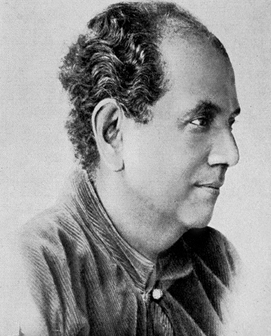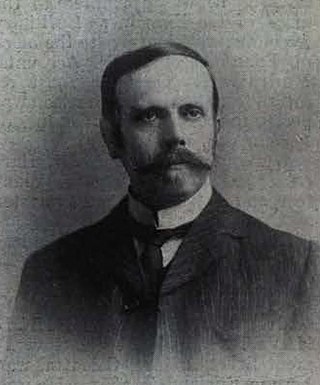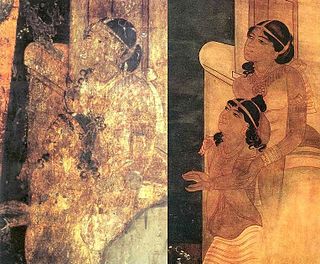Related Research Articles

Ananda Kentish Muthu Coomaraswamy was a Ceylonese metaphysician, historian and a philosopher of Indian art who was an early interpreter of Indian culture to the West. In particular, he is described as "the groundbreaking theorist who was largely responsible for introducing ancient Indian art to the West".

Mulk Raj Anand was an Indian writer in English, recognised for his depiction of the lives of the poorer class in the traditional Indian society. One of the pioneers of Indo-Anglian fiction, he, together with R. K. Narayan, Ahmad Ali and Raja Rao, was one of the first India-based writers in English to gain an International readership. Anand is admired for his novels and short stories, which have acquired the status of classics of modern Indian English literature; they are noted for their perceptive insight into the lives of the oppressed and for their analysis of impoverishment, exploitation and misfortune. He became known for his protest novel Untouchable (1935), which was followed by other works on the Indian poor such as Coolie (1936) and Two Leaves and a Bud (1937). He is also noted for being among the first writers to incorporate Punjabi and Hindustani idioms into English, and was a recipient of the civilian honour of the Padma Bhushan, the third-highest civilian award in the Republic of India.

Ratan Parimoo is an Indian art historian from Kashmir, who has worked as an art educator, pedagogue, artist and former director of the Lalbhai Dalpatbhai Museum, Ahmedabad. Ratan Parimoo was one of the founder members of Baroda Group.

Sir William Rothenstein was an English painter, printmaker, draughtsman, lecturer, and writer on art. Though he covered many subjects – ranging from landscapes in France to representations of Jewish synagogues in London – he is perhaps best known for his work as a war artist in both world wars, his portraits, and his popular memoirs, written in the 1930s. More than two hundred of Rothenstein's portraits of famous people can be found in the National Portrait Gallery collection. The Tate Gallery also holds a large collection of his paintings, prints and drawings. Rothenstein served as Principal at the Royal College of Art from 1920 to 1935. He was knighted in 1931 for his services to art. In March 2015 'From Bradford to Benares: the Art of Sir William Rothenstein', the first major exhibition of Rothenstein's work for over forty years, opened at Bradford's Cartwright Hall Gallery, touring to the Ben Uri in London later that year.

Indian art consists of a variety of art forms, including painting, sculpture, pottery, and textile arts such as woven silk. Geographically, it spans the entire Indian subcontinent, including what is now India, Pakistan, Bangladesh, Sri Lanka, Nepal, Bhutan, and at times eastern Afghanistan. A strong sense of design is characteristic of Indian art and can be observed in its modern and traditional forms.

The Bengal School of Art, commonly referred as Bengal School, was an art movement and a style of Indian painting that originated in Bengal, primarily Calcutta and Shantiniketan, and flourished throughout the Indian subcontinent, during the British Raj in the early 20th century. Also known as 'Indian style of painting' in its early days, it was associated with Indian nationalism (swadeshi) and led by Abanindranath Tagore (1871–1951), and was also being promoted and supported by British arts administrators like E. B. Havell, the principal of the Government College of Art and Craft, Kolkata from 1896; eventually it led to the development of the modern Indian painting.

Abanindranath Tagore was the principal artist and creator of the "Indian Society of Oriental Art". He was also the first major exponent of Swadeshi values in Indian art. He founded the influential Bengal school of art, which led to the development of modern Indian painting. He was also a noted writer, particularly for children. Popularly known as 'Aban Thakur', his books Rajkahini, Buro Angla, Nalak, and Khirer Putul were landmarks in Bengali language children's literature and art.

Indian painting has a very long tradition and history in Indian art. The earliest Indian paintings were the rock paintings of prehistoric times, such as the petroglyphs found in places like the Bhimbetka rock shelters. Some of the Stone Age rock paintings found among the Bhimbetka rock shelters are approximately 10,000 years old. Because of the climatic conditions in the Indian subcontinent, very few early examples survive today.

Ernest Binfield Havell, who published under the name E.B. Havell, was an influential English arts administrator, art historian and author of numerous books about Indian art and architecture. He was a member of the Havell family of artists and art educators. He was the principal of the Government School of Art, Calcutta from 1896 to 1905, where, along with Abanindranath Tagore, he developed a style of art and art education based on Indian rather than Western models, which led to the foundation of the Bengal school of art.

Nandalal Bose was one of the pioneers of modern Indian art and a key figure of Contextual Modernism.

Mukul Chandra Dey was one of five children of Purnashashi Devi and Kula Chandra Dey. He was a student of Rabindranath Tagore's Santiniketan and is considered as a pioneer of drypoint-etching in India. The entire family of Mukul Dey had artistic talents, the brother Manishi Dey was a well-known painter, and his two sisters, Annapura and Rani Chanda, were accomplished in arts and crafts as well.

Asit Kumar Haldar was an Indian painter of Bengal school and an assistant of Rabindranath Tagore at Shantiniketan. He was one of the major artists of the Bengal renaissance.

Sir Wilmot Parker Herringham was a British medical doctor, academic and author. He was one of the first doctors to investigate the effect and treatment of poison gas in World War I.

Christiana Jane Herringham, Lady Herringham was a British artist, copyist, and art patron. She is noted for her part in establishing the National Art Collections Fund in 1903 to help preserve Britain's artistic heritage. In 1910 Walter Sickert wrote of her as "the most useful and authoritative critic living".

This is a bibliography of notable works about the historical Indian subcontinent as well as the modern-day Republic of India.

Raman Siva Kumar, known as R. Siva Kumar, is an Indian contemporary art historian, art critic, and curator. His major research has been in the area of early Indian modernism with special focus on the Santiniketan School. He has written several important books, lectured widely on modern Indian art and contributed articles to prestigious international projects such as the Art Journal, Grove Art Online or The Dictionary of Art, Oxford University Press.

Kala Bhavana is the fine arts faculty of Visva-Bharati University, in Shantiniketan, India. It is an institution of education and research in visual arts, founded in 1919, it was established by Nobel laureate Rabindranath Tagore.
Paintings of Abanindranath Tagore is a book on Abanindranath Tagore's paintings by art historian R. Siva Kumar. It is widely considered as a landmark book in the Indian art scene that brings together a large corpus of Abanindranath's work for the first time. It fulfils a glaring lacuna in the picture of this master of modern Indian art.

The Passing of Shah Jahan is a Miniature painting, painted by the Indian artist Abanindranath Tagore in 1902. The painting depicts a scene in which the fifth Mughal Emperor Shah Jahan stares upon the Taj Mahal on his deathbed, with his daughter Jahanara Begum at his feet. Initially involved with the dominant style of European Naturalism, Tagore's mentor Ernest Binfield Havell had introduced him to various types of Indian art. Of these varieties, Tagore was most impressed with old Mughal miniatures, which often featured emotionless, but detailed illustrations of scenes and characters. Incorporating this style with the traditional Indian artistic concept of Bhava', or emotion, Tagore had painted a scene based upon the growing re-interest in Indian history during the British Raj.
The Indian Society of Oriental Art was an art society founded in Calcutta in 1907. It organised art exhibitions, taught students, and published high-quality reproductions and illustrated journals. founder by Abanindranath nath tagore
References
- ↑ Review, by K. R. Norman, of Coomaraswamy by Roger Lipsey, in Modern Asian Studies, Vol. 15, No. 2 (1981), pp. 339-341.
- ↑ South Asian Review, The Royal Society for India, Pakistan, and Ceylon, 1969, page 374.
- ↑ "Royal Society for India, Pakistan and Ceylon papers".
- ↑ The Times, 11 June 1919
- ↑ S.V. Turner, "Crafting Connections: The India Society and the Formation of an Imperial Artistic Network in Early Twentieth-Century Britain", in S. Nasta (eds) India in Britain, Palgrave Macmillan, London, 2013. https://doi.org/10.1057/9780230392724_7
- ↑ Mark Sedgwick, Against the Modern World: Traditionalism and the Secret Intellectual History of the Twentieth Century, Oxford University Press, 2004, page 52. ISBN 978-0-19-515297-5.
- ↑ The India Society Conference on Indian Art https://archive.org/stream/in.ernet.dli.2015.59212/2015.59212.The-India-Society-Conference-On-Indian-Art_djvu.txt. Retrieve 22 March 2021.
- ↑ "India Society | Making Britain".